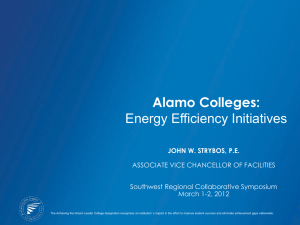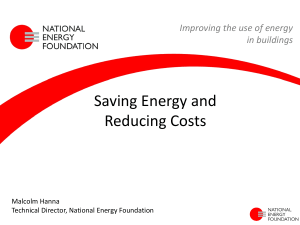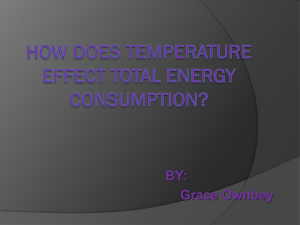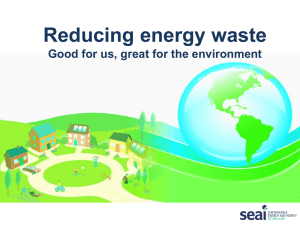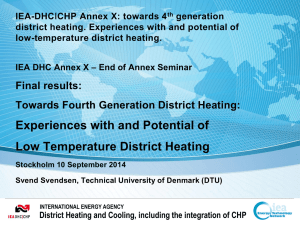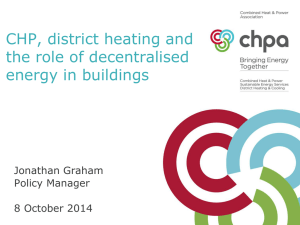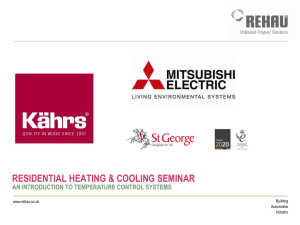INTERNATIONAL ENERGY AGENCY District Heating and Cooling
advertisement
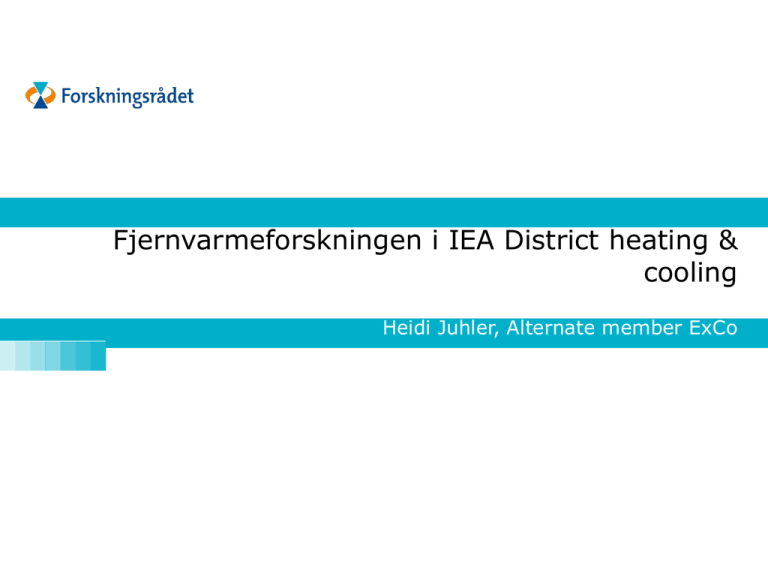
Fjernvarmeforskningen i IEA District heating & cooling Heidi Juhler, Alternate member ExCo IEA-DHCǀCHP Annex X: towards 4 th generation district heating. Experiences with and potential of low-temperature district heating. Presentation of the status report at the ExCo meeting New York, USA – 19 - 21 September, 2013 Hongwei Li Technical University of Denmark (DTU) INTERNATIONAL ENERGY AGENCY District Heating and Cooling, including the integration of CHP Project summary The goal of the project is to bring experience, knowledge and solutions for the 4 th Generation District Heating systems to a level where they are ready to be implemented widely. • Phase I: document experiences in mature DH countries with very low temperature systems serving highly energy-efficient new-build developments • Phase II: analyze and extend the scope of lessons arising from early examples of low- temperature systems, in order to improve the cost-effectiveness and environmental benefits, effectively formulating a blueprint for a new generation of district heating. slide 3 INTERNATIONAL ENERGY AGENCY District Heating and Cooling, including the integration of CHP Economic and Design Optimization in Integrating Renewable Energy and Waste Heat with District Energy Systems Presentation of the status report at the ExCo meeting New York City, USA - Sept. 19-21, 2013 Mark Spurr FVB Energy Inc. INTERNATIONAL INTERNATIONAL ENERGY ENERGY AGENCY AGENCY DistrictHeating Heating and and Cooling, the the integration of CHPof CHP District Cooling,including including integration 5 Renewable Energy & Waste Heat (REWH) High Grade Resources • Have reliably high temperatures that always exceed the DES supply temperature, and can be used directly whenever it is available. Low Grade Resources • Have lower temperatures that are sometimes or always insufficient relative to the DES supply temperature but always sufficient relative to the DES return temperature. • If the temperature of the source falls below the DES supply temperature, the temperature must be polished with other energy sources. Below Grade Resources • Always have temperatures lower than the return temperature in the DES, and must be upgraded with a heat pump. INTERNATIONAL ENERGY AGENCY District Heating and Cooling, including the integration of CHP 7 Temperature of REWH resource C F 248 100 212 80 176 60 140 40 104 20 68 0 32 Industrial waste heat Geothermal Reciprocating engines Flue gas Heat pumps Geo-exchange 120 Sewage heat recov. 284 Chiller heat recov. 140 Condensing heat rec. 320 Lubricating oil 160 Jacket water 356 Geothermal heat 180 Smelter off gas 392 Arc furnance (after rec.) 200 • At what temperature is the Renewable Energy or Waste Heat (REWH) available, and how does it compare with the supply and return temperatures of the DES? • Representative resource temperatures (at left), with heat pump increase shown in grey. INTERNATIONAL ENERGY AGENCY District Heating and Cooling, including the integration of CHP 8 Project Improved maintenance strategies for district heating pipe-lines Presentation of the status report at the ExCo meeting New York (USA) 19-21 September 2013 Nazdaneh Yarahmadi, SP Technical Research Institute of Sweden INTERNATIONAL ENERGY AGENCY District Heating and Cooling, including the integration of CHP Objectives of project • Tools for obtaining actual technical status of pre- insulated bonded pipes in operation • A model for decision making regarding actions to be taken based on – Technical status – Forecasted operational parameters – Requirements on robustness & redundancy – Costs for energy loss, maintenance & reconstruction • Predicted degradation & remaining technical life based on – Accelerated aged pipes – Pipes from field operation – Synthesis of available studies slide 10 INTERNATIONAL ENERGY AGENCY District Heating and Cooling, including the integration of CHP Status of project 1(3) • The accelerated ageing of pipes with both a standard and a thinner casing is continuing. • The pipes are exposed to an ambient temperature of 70°C. The service pipes are kept at four levels: 70°C, 130°C, 140°C and 150°C • Hence, accelerated ageing cause both deterioration of PUR at service pipe and deterioration of polyethylene casing. slide 11 INTERNATIONAL ENERGY AGENCY District Heating and Cooling, including the integration of CHP Development of Universal Calculation Model and Calculation Tool for Primary Energy Factors and CO Equivalents in District Heating and Cooling including CHP Contract number: IEA-X-C-004 Presentation of the status report at the ExCo meeting New York, USA of ExCo meeting – 19th, 20nd to 21st of September 2013 Jacob Stang SINTEF Energy INTERNATIONAL ENERGY AGENCY District Heating and Cooling, including the integration of CHP Additives Elec. Fuel handling Power grid Distribution net Production Construction and dismantling Construction and dismantling Ashes INTERNATIONAL ENERGY AGENCY Elec. (pumps) District Heating and Cooling, including the integration of CHP Building Ny utlysning for annex XI Temaer: Cost Reduction in District Heating & Cooling System Transformation from High to Low Temperature District Heating Operation Resource Planning and Business Development Søknadsfrist: 30. januar 2014 Tildeling: Mai 2014 Se for øvrig: http://iea-dhc.org/home.html
